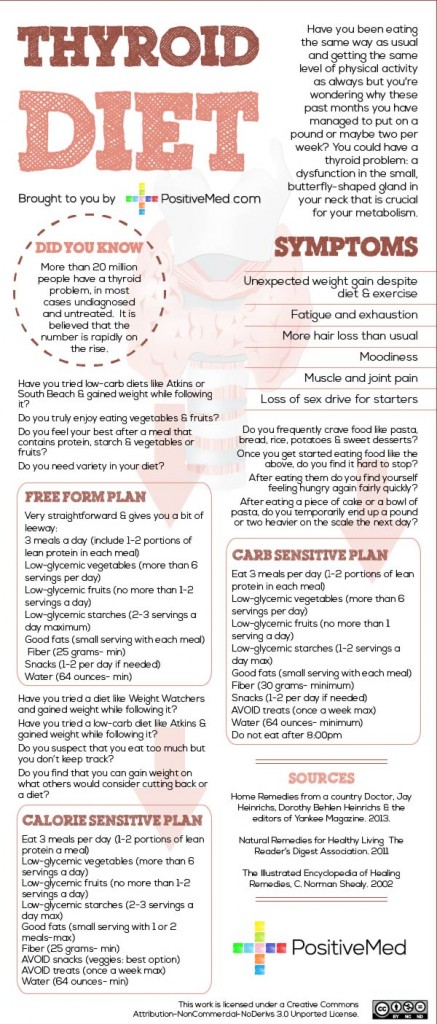The Thyroid Diet
Have you been eating the same way as usual and getting the same level of physical activity as always, but you’re wondering why these past months you have managed to put on a pound or maybe two per week?
It is very common that after this happens, you run directly to your doctor, because clearly something is wrong with you, but he probably will just tell you to stop eating so much and move off the couch, even though you are not doing that, or even give you a diet drug, because writing a prescription gives your doctor something useful and doctor-like to do.
But reality is you could have a thyroid problem, yep, a dysfunction in the small, butterfly-shaped gland in your neck that is crucial to your metabolism.
For millions of overweight people, thyroid disease is a very real reason for weight problems. That’s why learning about this disease and its symptoms is very important, since it can address the underlying cause of your weight gain, help restore your hope and health, and allow healthy diet and exercise to finally work the way they should. In fact more than 20 million have a thyroid problem and in most cases, undiagnosed and untreated, and it is believed that the number is rapidly on the rise.
The most common symptoms are: unexpected weight gain despite diet and exercise, fatigue and exhaustion, more hair loss than usual, moodiness, and muscle and joint pain.
It is very important to clarify that this diet does not involve any miraculous secrets or magic pills that will make pounds melt away, in fact getting treatment for your previously undiagnosed thyroid problem will be all that you need to return to a healthy weight, without a rigorous change in your diet and exercise.
Besides optimal thyroid treatment, you need to ensure that your metabolism works as best as it can, resolving underlying nutritional deficiencies, treating depression and correcting brain chemistry imbalances, reducing stress, combating insulin resistance, treating food allergies and sensitivities, and of course, exercising, all these may be treated with herbs and natural supplements. It is time for you to master your master metabolism gland.
The secret is to eat to live rather than live to eat. Your job is to find the system that is going to work best for you, there is no one on earth that has the same body as you, maybe similar but not the same, so you are the only one that can define the diet that suits you the best.
Next are some guidelines to help you determine which one diet plan is best for you.
- You have tried one of the low-carb diets like Atkins or South Beach, and you gained weight while following it.
- You truly enjoy eating vegetables and fruits
- You feel your best after a meal that contains protein, starch, and some vegetables or fruits.
- You need variety in your diet
- If you feel familiar with two or more of the above statements, then you should start with a free-form plan, which is straightforward and gives you quite a bit of leeway. Is basically a balanced, healthy starting point
- Eat 3 meals per day (each meal should include 1-2 portions of lean protein)
- Low-glycemic vegetables (all you want-more than 6 servings per day), low-glycemic fruits (1-2 servings per day, no more) and low-glycemic starches (2-3 servings a day maximum)
- Good fats (small serving with each meal) and fiber (25 grams- minimum)
- Snacks (1-2 per day if needed) treats (very sparingly and small servings-no more than once a week)
- Water (64 ounces- minimum)
If you:
- Frequently crave things like pasta, bread, rice, potatoes, and sweet desserts.
- Once you get started eating things like the above, you find it hard to stop.
- After you eat things like the above, you find yourself feeling hungry again fairly quickly.
- You find that after eating a piece of cake or a bowl of pasta, you temporarily end up a pound or two heavier on the scale the next day.
- If you feel familiar with two or more of the above statements, then it is likely that carbohydrates are a problem for you, and you should start the Carb-Sensitive Plan.
- Eat 3 meals per day (each meal should include 1-2 portions of lean protein)
- Low-glycemic vegetables (all you want-more than 6 servings per day), low-glycemic fruits (1 serving per day, no more) and low-glycemic starches (1-2 servings a day maximum)
- Good fats (small serving with each meal) and fiber (30 grams- minimum)
- Snacks (1-2 per day if needs) treats (avoid as possible, once per week maximum)
- Water (64 ounces- minimum)
- Do not eat after 8:00pm
And finally if you:
- Have tried a diet like Weight Watchers and gained weight while following it
- Have tried a low-carb diet like Atkins and gained weight while following it
- Suspect that you probably eat too much, but you don’t keep track
- Find that you can gain weight on what others would consider cutting back or a diet.
- If you feel familiar with two or more of the above statements, then you should start with the Calorie-Sensitive Plan.
- Eat 3 meals per day (each meal should include 1-2 portions of lean protein)
- Low-glycemic vegetables (all you want-more than 6 servings per day), low-glycemic fruits (1-2 servings per day, no more) and low-glycemic starches (2-3 servings a day maximum)
- Good fats (small serving with 1 or 2 meals-maximum) and fiber (25 grams- minimum)
- Snacks (avoid if possible-veggies, best option) treats (avoid if possible, once per week maximum)
- Water (64 ounces- minimum)
If you found yourself agreeing with many statements in all of the categories, then start out with the Free-Form Plan.
Source:
The Thyroid Diet. Mary J. Shomon. 2004


